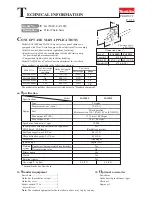
30
30
Teeth shape
“C” TYPE SHARPENING (HZ)
Coarse toothing with roughing tooth raked on both
sides and non-raked finishing tooth. The roughing
tooth is about 0.3 mm higher.
Coarse toothing with roughing tooth and finishing
tooth. Used in saws with pitch greater than or equal to
5 mm for cutting ferrous and non-ferrous materials with
solid or solid-profiled sections.
“BW” TYPE SHARPENING DIN 1838--UNI 4014
Coarse toothing with teeth alternately raked to the right
and left.
Toothing generally used on cut-off machines for
cutting ferrous and alloy materials with tubular and
profiled sections.
POSITIVE AND NEGATIVE CUTTING ANGLES
The cutting angle may vary from positive to negative depending on the cutting speed, the profile
and the type of material to be cut.
A positive angle determines better penetration of the tool and hence lower shear stress and
greater ease of sliding for the swarf over the cutting edge. On the other hand, the cutting edge
has lower mechanical resistance, so that as the breaking load of the material to be cut
increases, the cutting angle decreases from positive until it becomes negative, thus offering a
cutting edge with a larger resistant section.
Short swarf material such as brass, bronze, aluminum and hard cast iron require smaller cutting
angles because the swarf becomes crushed immediately and the rake angle has little effect
during the cutting stage.
Summary of Contents for CS-350EU
Page 17: ...14 14 OVERALL DIMENSIONS Machine Dimensions when assembled...
Page 35: ...32 32 BLADE SELECTION CHART...
Page 42: ...39 39 PARTS DRAWING A...
Page 47: ...44 44 PARTS DRAWING B...
Page 51: ...48 48 ELECTRICAL PARTS FU1 FU2 FU3 KR1 KR2 TC SA1 A1 M2 internal...
Page 52: ...49 49 SB4 SB1 SA2 SB2 SB3 VR A1 Display...
Page 58: ...55 55 NOTES...
Page 59: ...56 56 NOTES...
















































